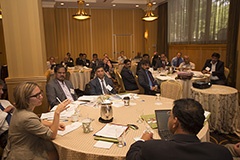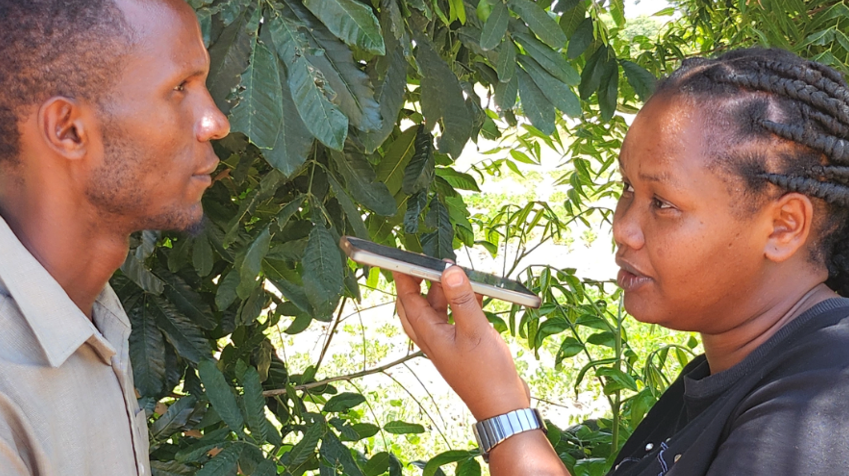A host of new technologies have been introduced for small-scale farmers in South Asia, along with new training materials, learning techniques, and financing models to promote their use. But it’s not always clear how well existing approaches are working. Are extension programs cost-effective in South Asia? Can new approaches empower smallholder farmers, particularly women? What performance indicators can researchers use to determine whether programs are successful? How can policies encourage farmers to adopt new technologies and practices without exhausting limited development funds?
These questions and more were addressed at recent workshop, “Strengthening Agricultural Research, Extension, and Input Markets in South Asia: Evidence from Regional and Global Practice,” held in Washington, DC. The event was organized by IFPRI in collaboration with the Cereal Systems Initiative for South Asia (CSISA), the International Maize and Wheat Improvement Center (CIMMYT), and Modernizing Extension and Advisory Services (MEAS).
The challenges of evaluating impact were the focus of the workshop’s first panel session. According to Gershon Feder from IFPRI, who has written widely on extension services, accountability is required for all publicly funded extension programs. To comprehensively monitor and evaluate the impact of a given program, researchers need to use multidisciplinary approaches and consider both direct and indirect beneficiaries.
Evaluations often tally the benefits of a particular extension modality but neglect to consider its costs. As a result, they provide little evidence about how cost-effective it is. Problems commonly emerge during data collection, when both time and funding are in short supply.
Moreover, the success of extension programs designed for specific target groups and conditions may not be applicable to other contexts. “The generalization problem can be solved by randomizing delivery of extension, which is something that we are trying to do a lot at IFPRI,” said Valerie Mueller, senior research fellow in IFPRI’s Development Strategy and Governance Division (DSGD). “Then we can compare the outcomes of similar farmers in communities who did and did not receive extension.”
Compared with their male counterparts, women farmers have poor access to extension and advisory services. This gap stems not only from a shortage of female extension agents, but also from the tendency of male agents not to view women farmers as intended targets of extension efforts. In the tropics, researchers have found that it is easier to recruit women as “farmer trainers” rather than calling them extension staff.
Steven Franzel, who leads research on rural advisory services at the World Agroforestry Centre (ICRAF), said women trainers deliver services to many more women than men do: In Cameroon, 74 percent of people trained by female trainers were women, whereas only 41 percent of people trained by male trainers were women. “Proactive measures are needed to increase women farmer trainers. It doesn’t happen by itself,” Franzel said. “Finding out the views of extension staff and farmers on performance of an extension approach is critical for evaluating it and finding ways to improve it.”
Beyond extension, there is also heavy interest in using direct subsidies to promote farmers’ adoption of agricultural inputs such as seed, fertilizer, water, and farm equipment—but there is a vigorous debate among policy analysts and researchers about the effectiveness of such subsidies. How can input subsidies be better designed to achieve increased efficiency and equity? This was the topic of the workshop’s second panel, chaired by Derek Byerlee.
Subsidies are often promoted as a means of addressing market failures that inhibit agricultural development. But Madhur Gautam, lead economist in Agriculture Global Practice at the World Bank, noted that the purported benefits only accrue under certain circumstances. Subsidies often remain in place long after their positive impacts have diminished, diverting scarce resources from other potential investments that may yield greater long-term returns, such as agricultural R&D and rural infrastructure.
In South Asia, subsidies were largely successful at addressing market failures during the early days of the Green Revolution. Yet market conditions in the region have improved considerably, and policymakers need to adapt their policies and investments accordingly.
Shahidur Rashid, senior research fellow in IFPRI’s Markets, Trade, and Institutions Division (MTID), pointed to the need for “smart” subsidies that promote the development of the private sector and target farmers who were not previously using agricultural inputs in order to achieve greater cost-effectiveness. Such subsidies can form part of a wider strategy that aims to strengthen local and regional markets, promote competition, and lower costs by effectively reducing barriers to entry, as well as including a plan for phasing out inefficient subsidies.
Based on research conducted in eastern Uttar Pradesh, India, David Spielman, senior research fellow with IFPRI’s Environment and Productions Technology Division (EPTD), described how innovative targeting can be used to stimulate demand for laser land-leveling services, which increase water use efficiency in irrigated agriculture while lowering production costs. Implementing a simple discount on these services for the first hour of use could serve as a cost-effective way to increase farmer demand and adoption rates as well as increasing groundwater use efficiency.
The effort to target subsidies can be costly. Patrick Ward, another research fellow from EPTD, shared findings from an ongoing research project that hint at one promising strategy for reducing costs. By effectively bundling two risk-management tools—drought-tolerant rice and weather-based insurance—Ward and his colleagues significantly raised farmers’ willingness to invest in these new technologies. According to Ward, this finding runs counter to the common misconception that farmers are not interested in insurance and are unwilling to pay a fair market price for it.
Could other complementary technologies be bundled together to improve farmer adoption rates and cost-effectiveness of extension programs in South Asia and other regions? As these services are scaled up and subject to ever more evaluation, researchers are seeking to provide policymakers with evidence on what works best and at the lowest cost.
With contributions from Patrick Ward, Research Fellow at IFPRI’s Environment and Production Technologies Division. Ward is based at IFPRI’s New Delhi Office.







